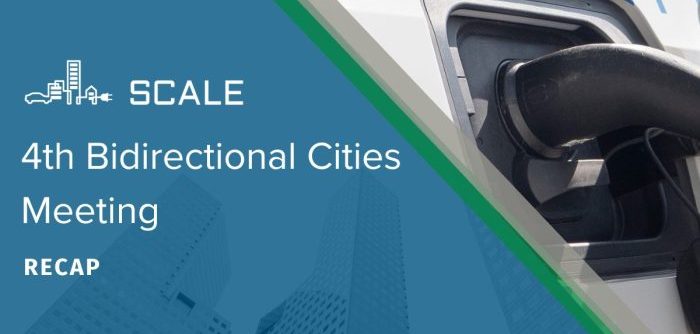Last year, SCALE launched a series of events focused on Vehicle-to-Grid (V2G) Implementation and Procurement, as part of a Joint Procurement Programme, specifically designed for those responsible for public charging infrastructure (destination charging) in cities and regions – from local authorities to grid operators. The first webinars at the end of 2024 gathered ten cities from around Europe with varying levels of experience in deploying smart and V2G/V2X charging infrastructure. By the third and fourth iterations, a total of 150 organisations are connected to these Bidirectional cities events.
The event opened with a welcome from Gertjan Geurts from the City of Utrecht who provided an overview of the objectives of the meeting: a review of the new SCALE Procurement guidelines, an update on Utrecht’s V2G project and an introduction to the upcoming V2X Alliance, in which stakeholders are welcome to provide feedback to its structure and governance.
Frank Geerts (ElaadNL) then gave an overview of the new SCALE procurement guidelines for smart and bidirectional charging infrastructure that was put together based on practical experience in cities like Utrecht and shaped by feedback from stakeholders across Europe. The key principles put forward include to procure V2G readiness (smart charging now, bidirectional charging capable), use the current open standards in order to avoid vendor lock-in, and collaborate with grid operators.
The Guidelines have been published as SCALE result and proposed for inclusion as annex to the EU STF Procurement Handbook. They will be periodically updated, the newest version can be found here.
Bart van der Ree then led a discussion on the relevance and applicability of these Guidelines.
The key topics discussed included the proper definition of ‘V2G-ready’, legal and technical translation into procurement, demand for templates and flexibility, and – in conclusion – that these guidelines are a useful tool but users will need to review them and possibly adapt them to suit local contexts.
The next presentation was given by Robin Berg, from We Drive Solar, who gave an update on the 50 public bidirectional AC charging points that were to go live on 4 June with 50 Renault 5s, that were in the testing phase during the event. By early June, these 50 EV’s will be operated in V2G mode, reacting to the EPEX day-ahead market prices. The collaboration between the city, We Drive Solar, Renault, MyWheels, ElaadNL and Stedin (DSO), shows that V2G is technically feasible – and, according to Berg, the focus is now on “regulation, cooperation, and scaling.”
Gertjan Geurts then introduced the work to build a V2X Alliance: European collaboration between cities, DSOs, regions, market players (also open to non-European members). Interested organizations are welcome to approach Gertjan, via e-mail or LinkedIn.
Finally, POLIS led an open discussion based on the results of an online survey shared with participants on the barriers and opportunities of V2G in local contexts – a dialogue with the cities about the relevance and applicability of the guidelines.
SAVE THE DATE: The 5th and final Bidirectional Cities event will take place in a hybrid format during 24-25 November 2025 in Utrecht during the SCALE project’s final project event, “Scaling Smart & V2X EV Charging”.
Resources:
Recording of the webinar

